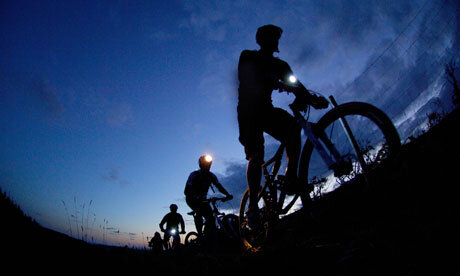Bike Lights and Night Riding: Laws and Suggestions
In this installment of our Bike Safety series, we talk about bike lights and night riding. Check out the rest of our series to learn more about varies issues pertaining to bike safety and laws in CU.I spend a fair bit of time in Neutral Cycle's campus shop on Fifth and Green and I've seen a lot of bikes get sold. With these bikes we almost always end up selling one thing: a lock. These are seen as essential, protecting a bike from theft while unwatched by its owner. (And we've written our fair share of posts about biketheft and locking your bike.) What we don't end up selling is something equally essential: a bike light. If you value the preservation of your bike and your body's current physical condition, then the $30 investment in a nice set of lights is unquestionably worth it. We've written about bike lights before, but they're important enough to be included as their own entry in our Bike Safety series.A lot of people in CU, particularly students, ride at night without even a headlight. This isn't just a CU problem. A survey of night bikers done in Minneapolis, the third-most bicycle-friendly city in the US, according to Bicycling magazine, found that 42% of cyclists riding at night didn't have bike lights.What you (legally) must have:Illinois law requires two things for night riding:
A red reflector on the rear visible from up to 600 feet when in front of a car's headlights.
A front light that (a) emits white light and that (b) can be seen from a distance of up to 500 feet.
If you don't have these, you can, in theory be pulled over and ticketed by the police. As far as I can remember, when I was looking at bike tickets in CU issued in the past 1-2 years, there was only one case or so of a ticket being issued for a light violation, and even then it was only in tandem with another offense.But don't let that stop you from getting a light. The reason you need lights is so that you hurt neither yourself nor others, not because you don't want a ticket.What you should have:For optimum safety, you should get both a headlight and a taillight. Taillights are much easier to see for cars and others behind you because it doesn't merely reflect light (as does a reflector... obviously...) but it produces its own light too. So taillight, yes. But flashing or steady? For a discussion as to whether it's better to have a flashing or steady taillight, refer to this discussion. In short, most agreed that it's best to have a flashing taillight (and also headlight) because (a) it's perceived to be brighter by the human eye and (b) it's a 'less natural' type of light that is more eye-catching, both of these making you more conspicuous to an observer. That said, some find blinking lights distracting and believe them to have the opposite effect in terms of keeping bikers safer, and there's also the issue of photosensitive epilepsy. The debate rages on.For the past six years, the Bike Project of Urbana-Champaign has a yearly event in the Fall called Light the Night where they give out and install headlights and taillights for free, to help increase bike safety in the CU area.If you don't have bike lights (or just have a headlight), come by Neutral Cycle and pick out a set.Biking at nightSo after all that talk bike lights, what else can you do, beyond having lights, to increase your visibility on the road. First, make sure your bike has other reflectors. Illinois law requires that all new bikes be sold with a colorless reflector on the front, reflectors on your pedals, and reflectors on the side of your bike. If you have an older bike, then your bike may not be equipped with these safety features.Another, more important way to increase your visibility is to wear clothing and accessories that makes you easily visible. Avoid black if you can, and invest in clothing meant for biking that incorporates reflective material on it or wear reflective bands on your ankle and knees. These are actually pretty effective in increasing your visibility. You want to make yourself as conspicuous as possible in order to avoid getting hit. Unfortunately, studies have shown that people assume they're much more visible than they are. The best solution is to evaluate what you're proactively doing to make yourself visible to cars and identify what you can do to make yourself even more visible. Let us know if you have any suggestions that we failed to mention!

